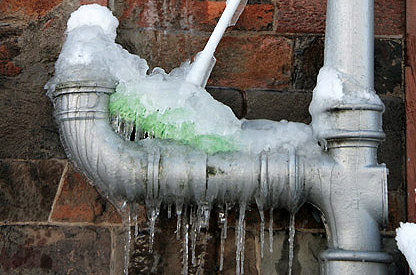The content down below pertaining to Helpful Tips to Prevent Frozen Pipes this Winter is relatively entertaining. Have a go and make your own personal assumptions.

Winter can ruin your pipes, particularly by freezing pipes. Below's just how to avoid it from taking place and what to do if it does.
Introduction
As temperatures decrease, the danger of frozen pipes boosts, possibly bring about expensive repair services and water damage. Understanding exactly how to avoid frozen pipes is important for property owners in chilly climates.
Understanding Icy Pipes
What causes pipelines to ice up?
Pipes freeze when subjected to temperature levels below 32 ° F (0 ° C) for prolonged periods. As water inside the pipes freezes, it increases, putting pressure on the pipeline walls and potentially causing them to rupture.
Risks and problems
Frozen pipes can lead to water system disturbances, property damage, and expensive repair work. Burst pipes can flood homes and create substantial structural damage.
Indicators of Frozen Pipes
Recognizing frozen pipelines early can avoid them from breaking.
How to recognize frozen pipelines
Look for lowered water flow from taps, unusual smells or noises from pipelines, and visible frost on revealed pipes.
Avoidance Tips
Shielding vulnerable pipes
Cover pipelines in insulation sleeves or use warmth tape to protect them from freezing temperatures. Focus on pipes in unheated or exterior locations of the home.
Home heating techniques
Maintain interior areas appropriately warmed, especially areas with plumbing. Open up cupboard doors to allow cozy air to circulate around pipelines under sinks.
Safeguarding Outdoor Pipes
Yard hose pipes and outdoor faucets
Disconnect and drain garden hoses before winter season. Set up frost-proof faucets or cover outdoor taps with shielded caps.
What to Do If Your Pipelines Freeze
Immediate activities to take
If you believe icy pipelines, maintain faucets available to ease stress as the ice melts. Make use of a hairdryer or towels taken in hot water to thaw pipes gradually.
Long-Term Solutions
Structural changes
Consider rerouting pipelines away from outside walls or unheated areas. Include added insulation to attics, cellars, and crawl spaces.
Updating insulation
Invest in high-grade insulation for pipes, attics, and wall surfaces. Proper insulation assists preserve regular temperatures and minimizes the threat of icy pipes.
Conclusion
Preventing frozen pipelines needs aggressive actions and fast feedbacks. By recognizing the causes, signs, and preventive measures, house owners can secure their pipes throughout cold weather.
5 Ways to Prevent Frozen Pipes
Drain Outdoor Faucets and Disconnect Hoses
First, close the shut-off valve that controls the flow of water in the pipe to your outdoor faucet. Then, head outside to disconnect and drain your hose and open the outdoor faucet to allow the water to completely drain out of the line. Turn off the faucet when done. Finally, head back to the shut-off valve and drain the remaining water inside the pipe into a bucket or container. Additionally, if you have a home irrigation system, you should consider hiring an expert to clear the system of water each year.
Insulate Pipes
One of the best and most cost-effective methods for preventing frozen water pipes is to wrap your pipes with insulation. This is especially important for areas in your home that aren’t exposed to heat, such as an attic. We suggest using foam sleeves, which can typically be found at your local hardware store.
Keep Heat Running at 65
Your pipes are located inside your walls, and the temperature there is much colder than the rest of the house. To prevent your pipes from freezing, The Insurance Information Institute suggests that you keep your home heated to at least 65 degrees, even when traveling. You may want to invest in smart devices that can keep an eye on the temperature in your home while you’re away.
Leave Water Dripping
Moving water — even a small trickle — can prevent ice from forming inside your pipes. When freezing temps are imminent, start a drip of water from all faucets that serve exposed pipes. Leaving a few faucets running will also help relieve pressure inside the pipes and help prevent a rupture if the water inside freezes.
Open Cupboard Doors
Warm your kitchen and bathroom pipes by opening cupboards and vanities. You should also leave your interior doors ajar to help warm air circulate evenly throughout your home.

As a keen person who reads about Winter Plumbing Precautions: Preventing Frozen Pipes, I thought sharing that article was beneficial. Sharing is caring. Helping others is fun. I thank you for reading our article about Helpful Tips to Prevent Frozen Pipes this Winter.
Request Appointment